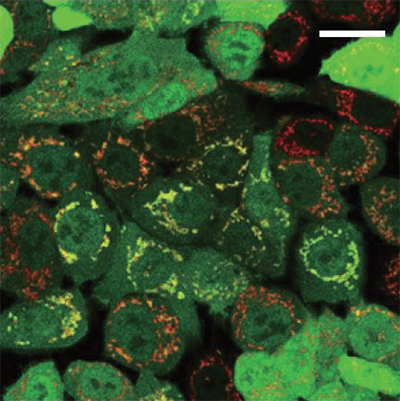JBC: Researchers link new protein to Parkinson’s
Researchers in Japan are reporting new insight into how the Parkinson’s disease-associated protein parkin selects its targets. The finding might improve experimental therapies for Parkinson’s that aim to boost parkin activity.

Cells depend on parkin to help get rid of damaged mitochondria. The research, published in the Journal of Biological Chemistry, suggests that parkin depends on other proteins, including one called MITOL that has not been linked previously to Parkinson’s disease, to direct it to those damaged mitochondria.
Parkin adds a degradation tag called ubiquitin to proteins on the mitochondrial surface. In some patients with familial Parkinson’s disease, parkin activity is disrupted and bad mitochondria cannot be destroyed. Harmful byproducts from those bad mitochondria can damage neurons. By understanding how parkin works and what goes wrong when it’s mutated, researchers hope also to help patients with other forms of Parkinson’s disease.
While other ubiquitin-tagging proteins, known as E3 ligases, recognize specific amino acid sequences on their substrates, parkin has many known substrates that don’t seem to share a sequence in common. While studying how parkin chooses its substrates, researchers led by Fumika Koyano in Noriyuki Matsuda’s lab at the Tokyo Metropolitan Institute of Medical Science discovered that parkin can tag any lysine-containing protein with ubiquitin — even a bacterial protein not ordinarily found in the cell — as long as it’s present at the surface of the mitochondria.
“Parkin is not regulated by its substrate specificity,” Koyano said of the finding. Instead, control of parkin activity comes from how it is recruited and activated by other proteins.
The discovery that activated parkin is not terribly selective led Koyano and her colleagues to take a closer look at parkin’s recruitment and activation. Some details of that process are well known; for example, a protein called PINK1 is known to boost parkin activity. But Koyano and colleagues discovered a new step that must happen before PINK1 can contribute to parkin activation. They found that parkin acts more rapidly when a first ubiquitin molecule is already present, acting as a seed for the addition of more ubiquitins. In most cases, the researchers found, this seed ubiquitin is added by a protein called MITOL, which had not been linked previously to Parkinson’s.
The research could contribute to the design of new drugs, some of which aim to boost parkin activity to slow the advance of Parkinson’s disease.
“If we achieve upregulation of seed ubiquitylation on mitochondria,” Koyano said, “it might accelerate parkin recruitment and parkin activation to eliminate damaged mitochondria more efficiently.”
Enjoy reading ASBMB Today?
Become a member to receive the print edition four times a year and the digital edition monthly.
Learn moreGet the latest from ASBMB Today
Enter your email address, and we’ll send you a weekly email with recent articles, interviews and more.
Latest in Science
Science highlights or most popular articles

Using DNA barcodes to capture local biodiversity
Undergraduate at the University of California, Santa Barbara, leads citizen science initiative to engage the public in DNA barcoding to catalog local biodiversity, fostering community involvement in science.

Targeting Toxoplasma parasites and their protein accomplices
Researchers identify that a Toxoplasma gondii enzyme drives parasite's survival. Read more about this recent study from the Journal of Lipid Research.

Scavenger protein receptor aids the transport of lipoproteins
Scientists elucidated how two major splice variants of scavenger receptors affect cellular localization in endothelial cells. Read more about this recent study from the Journal of Lipid Research.

Fat cells are a culprit in osteoporosis
Scientists reveal that lipid transfer from bone marrow adipocytes to osteoblasts impairs bone formation by downregulating osteogenic proteins and inducing ferroptosis. Read more about this recent study from the Journal of Lipid Research.

Unraveling oncogenesis: What makes cancer tick?
Learn about the ASBMB 2025 symposium on oncogenic hubs: chromatin regulatory and transcriptional complexes in cancer.

Exploring lipid metabolism: A journey through time and innovation
Recent lipid metabolism research has unveiled critical insights into lipid–protein interactions, offering potential therapeutic targets for metabolic and neurodegenerative diseases. Check out the latest in lipid science at the ASBMB annual meeting.

